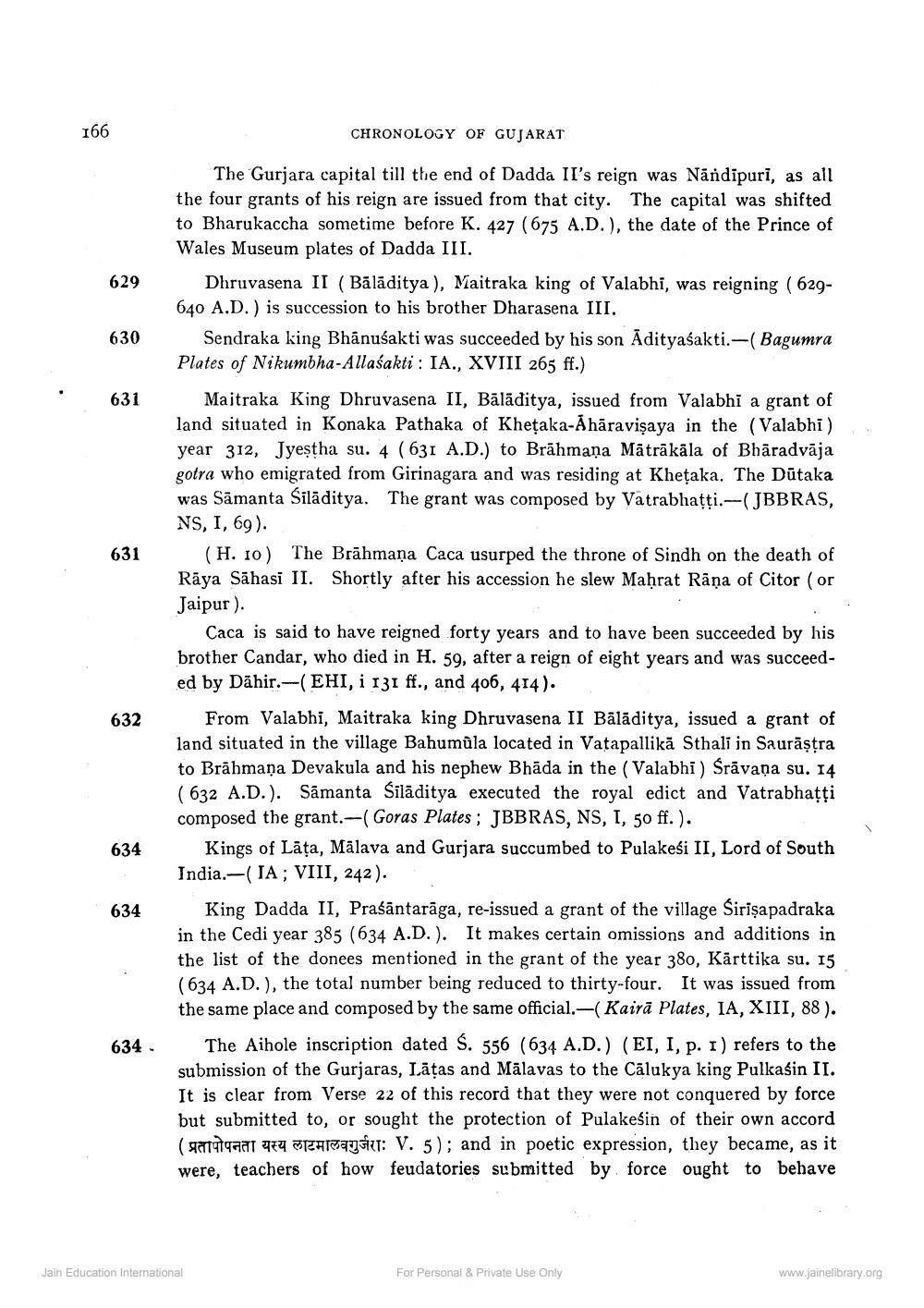________________
166
CHRONOLOGY OF GUJARAT
629
630
631
631
The Gurjara capital till the end of Dadda II's reign was Nandipuri, as all the four grants of his reign are issued from that city. The capital was shifted to Bharukaccha sometime before K. 427 (675 A.D.), the date of the Prince of Wales Museum plates of Dadda III.
Dhruvasena II (Bālāditya), Maitraka king of Valabhi, was reigning (629640 A.D.) is succession to his brother Dharasena III.
Sendraka king Bhānusakti was succeeded by his son Adityasakti.-(Bagumra Plates of Nikumbha-Allaśakti : IA., XVIII 265 ff.)
Majtraka King Dhruvasena II, Bālāditya, issued from Valabhi a grant of land situated in Konaka Pathaka of Khețaka-Ahāravişaya in the (Valabhi) year 312, Jyeștha su. 4 (631 A.D.) to Brāhmaṇa Mātrākāla of Bhāradvāja gotra who emigrated from Girinagara and was residing at Khetaka. The Dūtaka was Samanta Silāditya. The grant was composed by Vatrabhatti.---( JBBRAS, NS, I, 69).
(H. 10) The Brāhmaṇa Caca usurped the throne of Sindh on the death of Rāya Sāhasi II. Shortly after his accession he slew Mahrat Rāņa of Citor (or Jaipur).
Caca is said to have reigned forty years and to have been succeeded by his brother Candar, who died in H. 59, after a reign of eight years and was succeeded by Dāhir.-(EHI, i 131 ff., and 406, 414).
From Valabhi, Maitraka king Dhruvasena II Bālāditya, issued a grant of land situated in the village Bahumula located in Vatapallikā Sthali in Saurāştra to Brāhmaṇa Devakula and his nephew Bhāda in the Valabhi) Srāvana su. 14 ( 632 A.D.). Samanta Sīlāditya executed the royal edict and Vatrabhațți composed the grant.-(Goras Plates; JBBRAS, NS, I, 50 ff.).
Kings of Lāța, Mālava and Gurjara succumbed to Pulakeši II, Lord of South India.-(IA; VIII, 242).
King Dadda II, Praśāntarāga, re-issued a grant of the village Sirisapadraka in the Cedi year 385 (634 A.D.). It makes certain omissions and additions in the list of the donees mentioned in the grant of the year 380, Kārttika su. 15 (634 A.D.), the total number being reduced to thirty-four. It was issued from the same place and composed by the same official.-( Kairā Plates, IA, XIII, 88).
The Aihole inscription dated $. 556 (634 A.D.) (EI, I, p. I) refers to the submission of the Gurjaras, Lāțas and Mālavas to the Cālukya king Pulkasin II. It is clear from Verse 22 of this record that they were not conquered by force but submitted to, or sought the protection of Pulakesin of their own accord ( atgaat 984 Araufiit: V. 5); and in poetic expression, they became, as it were, teachers of how feudatories submitted by force ought to behave
632
634
634
634
Jain Education Intemational
For Personal & Private Use Only
www.jainelibrary.org




